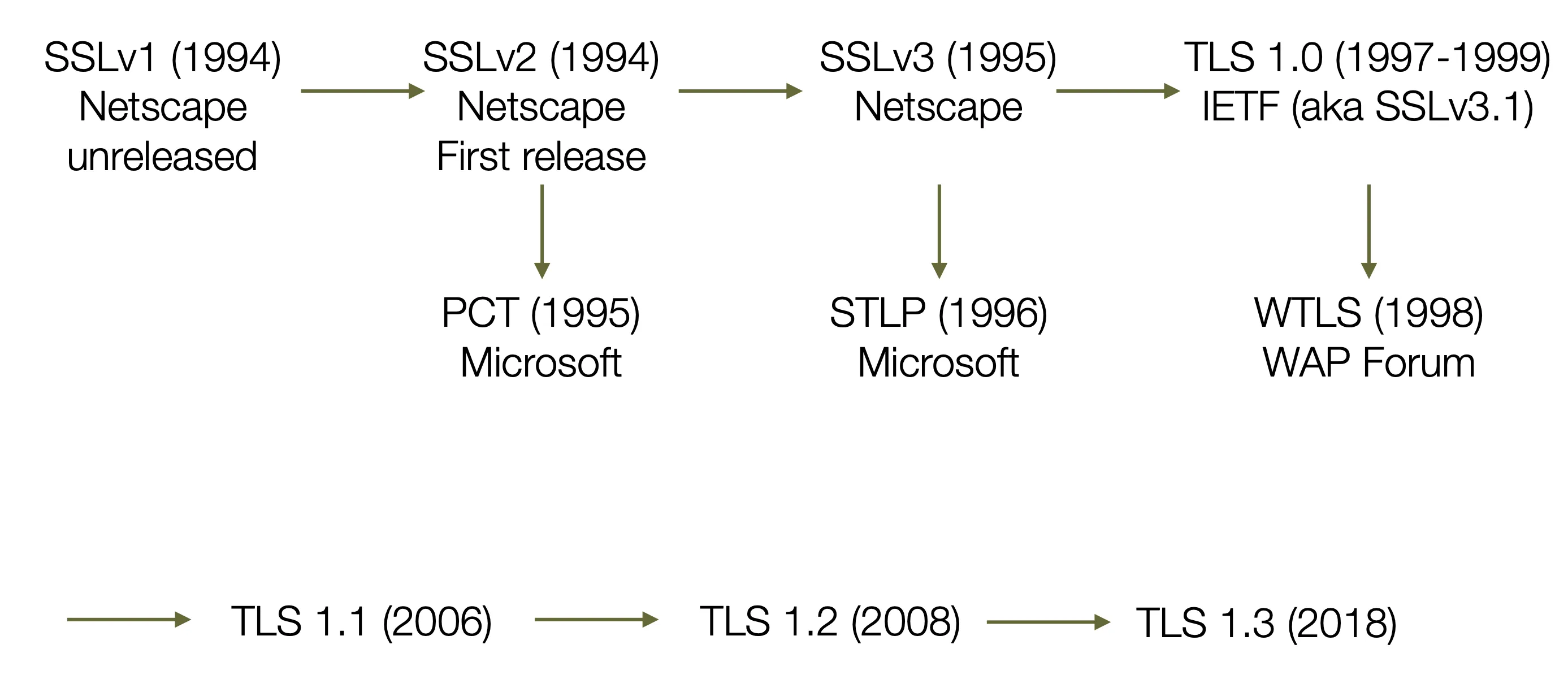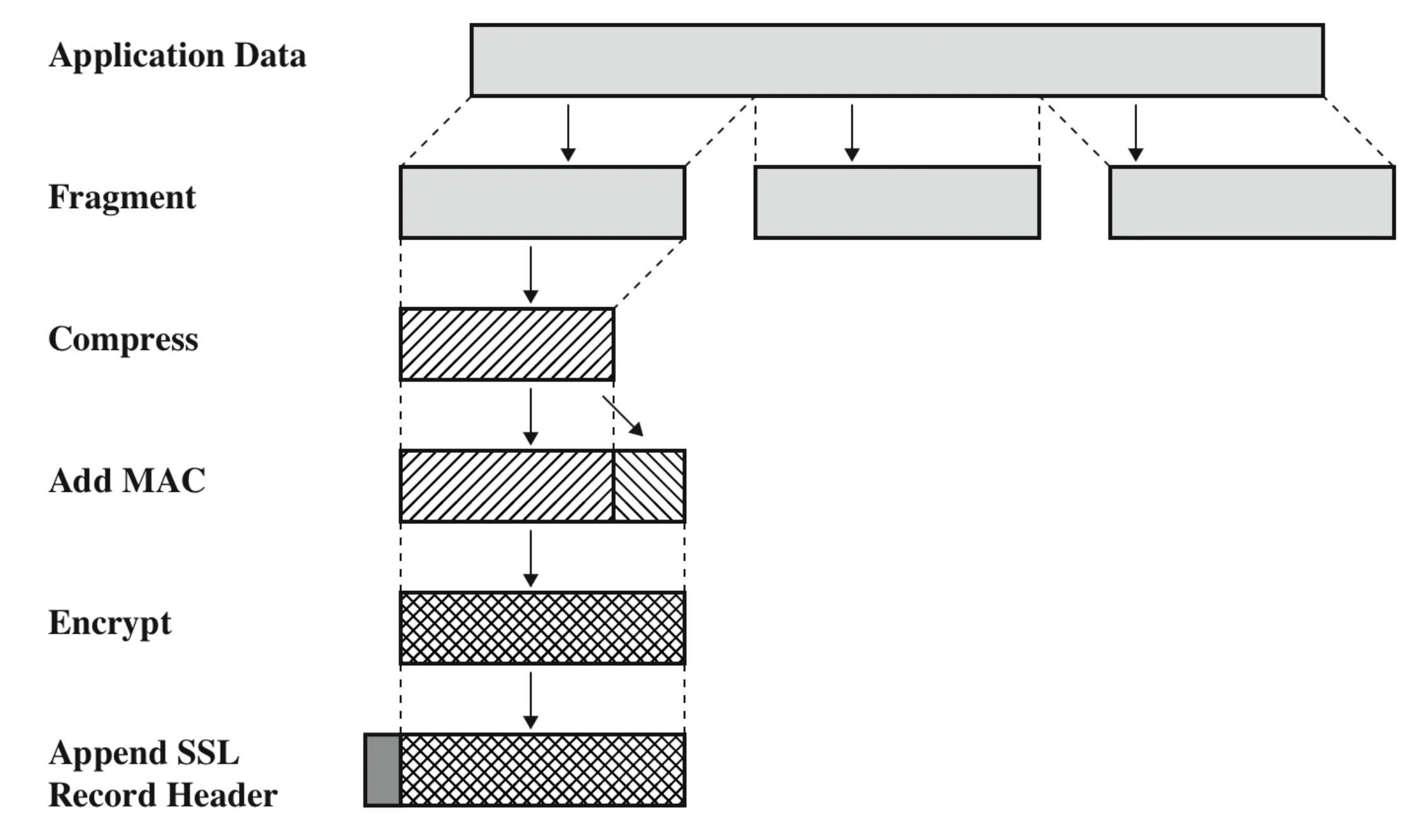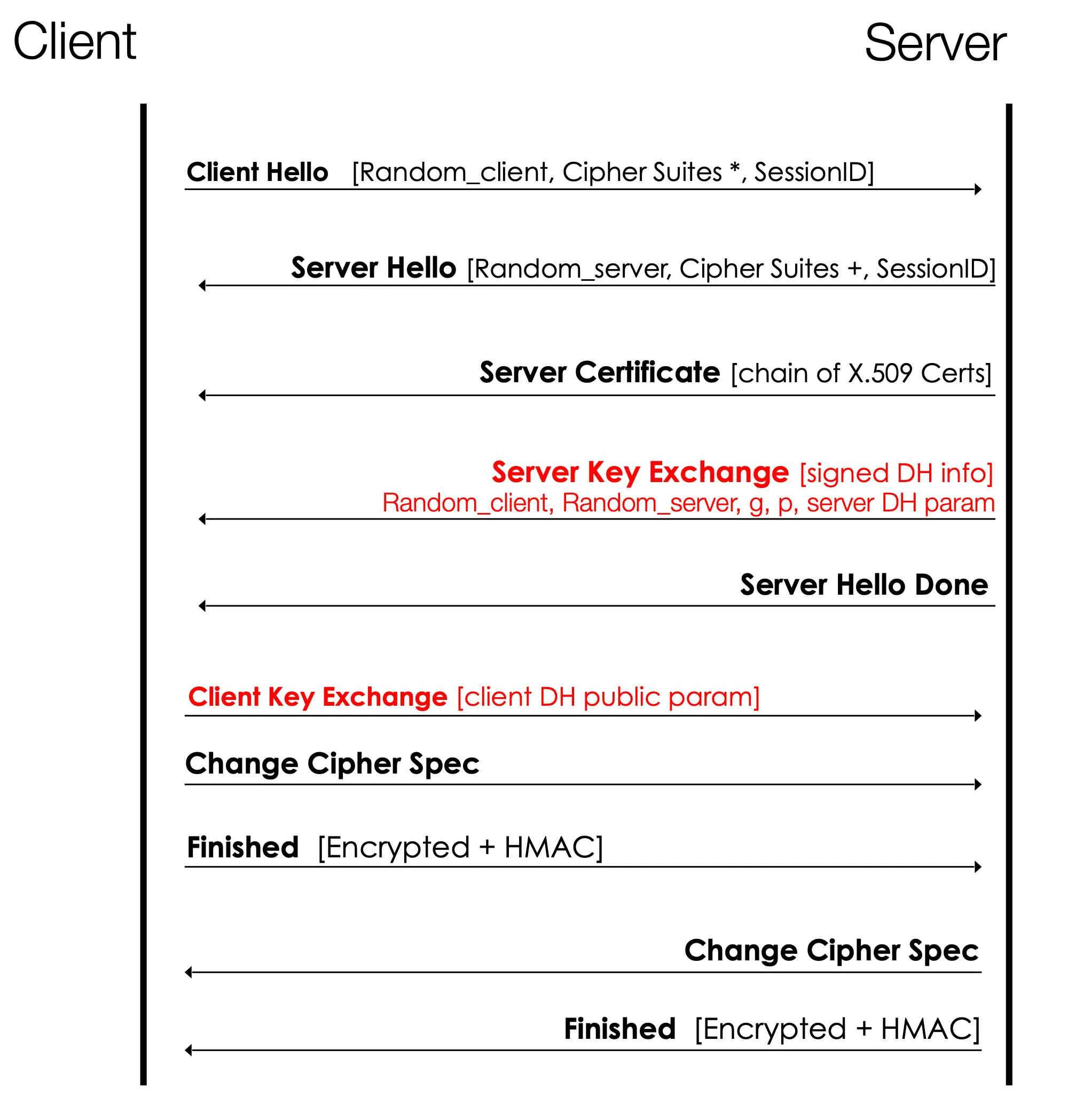TLS
Introductions
- introductions of two students
Questions on the readings
The readings today are from Computer Security and the Internet, Chapter 9, sections 9.2
SSL and TLS hsitory

Source of image: SSL and TLS, Rescorla
SSL record structure

Source of image: Network and Security Essentials, Stallings
TLS handshake and DH key exchange
- the main purpose of the TLS handshake is to etablish a shared key
- note this shows Diffie-Hellman, but there are a variety of ways to complete the handshake

-
parts of the handshake
-
Client Hello
- Random client: random number used later to derive shared key
- Cipher Suites: zero or more
- Session ID: can be used to update or resume a connection
-
Server Hello
- Random server: random number used later to dervice shared key
- Cipher Suite: the single cipher suite selected from the client’s list (or the connection is closed if none is available)
- Session ID: can indicate a resumed connection or a new connection
-
Server Certificate
- a chain of certificates that authenticate the server to the client
-
Server Key Exchange
- random client from above
- random server from above
- signed Diffie-Hellman parameters
-
Server Hello Done
- empty, signals end of key exchange messages
- note, this is needed because, e.g. Server Key Exchange message may not be needed
-
Client Key Exchange
- public Diffie Hellman message
-
Change Cipher Spec
- potentially multiple messages to change the cipher suite
-
Finished
- sent after cipher change messages
- verifies the key exchange and authentication was successful
- contains some data to verify the previous exchanges — HMAC of master secret, a text string, hash of hasndshake messages
- first message protected with the negotiated algorithms, keys, and secrets
- after this message, the peers can exchange data
-
everything after the key exchange is encrypted and protected with a MAC (unless AES GCM mode used) — this means an attacker cannot modify algorithms chosen
-
can use a pre-shared key, meaning a key from a previous session
-
Diffie-Hellman keys are ephemeral — erased after use
-
TLS Cipher Suites
-
defines the algorithms used during the TLS connection
- key exchange algorithm — for exchanging/creating a symmetric encryption key
- authentication algorithm — for digital signatures
- bulk encryption algorithm — for encrypting the data
- MAC algorithm — for security
-
example: ECDHE-ECDSA-AES128-GCM-SHA256
- ECDHE: Elliptic-curve Diffie-Hellman
- ECDSA — Elliptic-curve Digital Signature Algorithm
- AES 128 — AES with 128-bit key
- GCM — Galois/Counter Mode — block cipher with high performance (parallelizable) and patent-free
- SHA256 — MAC algorithm
Organization and Extended Validation certificates
types of certificates
-
DV (Domain Validated) certificates
- demonstrate control of the domain, which could be responding to email sent
to
admin@domain.com - inexpensive or free
- demonstrate control of the domain, which could be responding to email sent
to
-
OV (Organization Validated) certificates
- manual checks to certify ownership of a real-world organization
-
EV (Extended Validation) certificates verify
- real-world existance of a legal entity in the
Subject - registration in government-recognized databases
- physical existence matching location in certificate
- identity of person requesting certificate and their relationship to the organization
- control of the domain
- real-world existance of a legal entity in the
-
IV (Individual validated) certificates
- user decided to trust them (e.g. self-signed certificates)
-
users don’t know the difference between DV, OV, and EV
-
thus not very useful
-
see An Evaluation of Extended Validation and Picture-in-Picture Phishing Attacks — study showing Internet Explorer EV certificate interface didn’t help users identify phishing attacks
-
can’t prove a CA takes these validation steps anyway
-
Attacks on TLS
-
rogue certificates — see Hackers spied on 300,000 Iranians using fake Google certificate, 2011
-
TLS stripping attacks — block the signal to upgrade from HTTP to HTTPS
- see website configuration below
- use browser tools to see the redirect
- see HTTPS Everywhere browser extension
- revocation failures can be exploited
-
difficulties with browser trust model
- how do users or browsers decide who is trustworthy and who is not?
- poor trust agility — no system to dynamically add/remove certificates from the root store, it’s up to the OS or browser vendor
- intermediate CAs are unaccountable — can only remove root CAs
-
certificate transparency helps expose rogue certificates
- this uses a blockchain to track all certificates
- an attacker can avoid putting a rogue certificate into the blockchain, but then browsers will reject it as not valid
- an attacker can put the rogue certificate into the blockchain, and then once caught the signing CA will be banned
- so the system helps shorten the lifetime of attacks
- for details, see Certificate Transparency
Other TLS topics
-
TLS flaws are serious
- a bug in TLS affects massive amounts of ecommerce
- see Heartbleed 101 and the included xkcd comic
- see TLS Security 6: Examples of TLS Vulnerabilities and Attacks for a decent overview of past attacks
-
the widespread use of CDNs for content delivery means CDNs have wbesite private keys
- see Content Delivery Network for a good picture of a CDN
- see Measurement and Analysis of Private Key Sharing in the HTTPS Ecosystem
- see When HTTPS Meets CDN: A Case of Authentication in Delegated Service